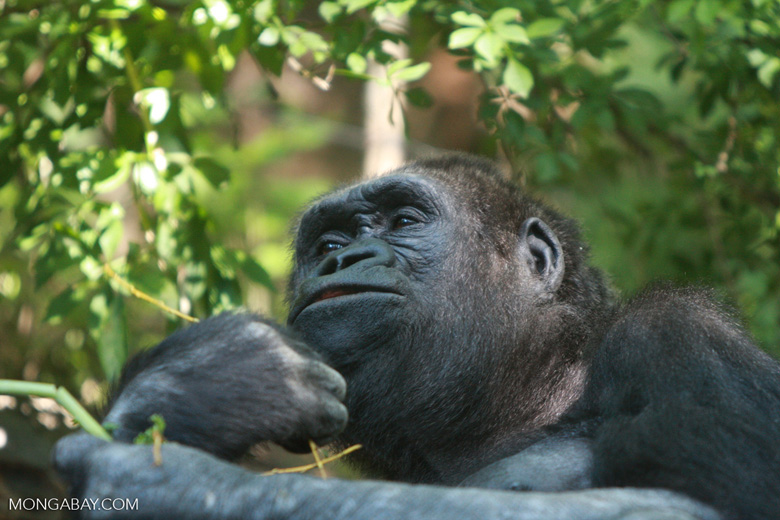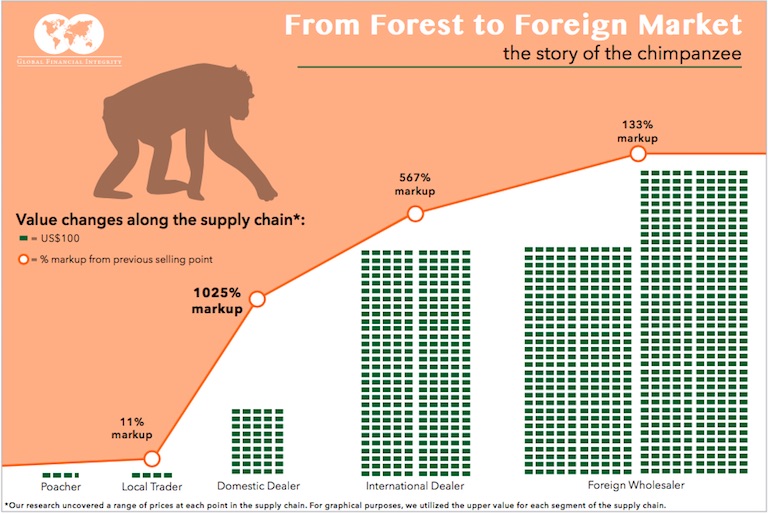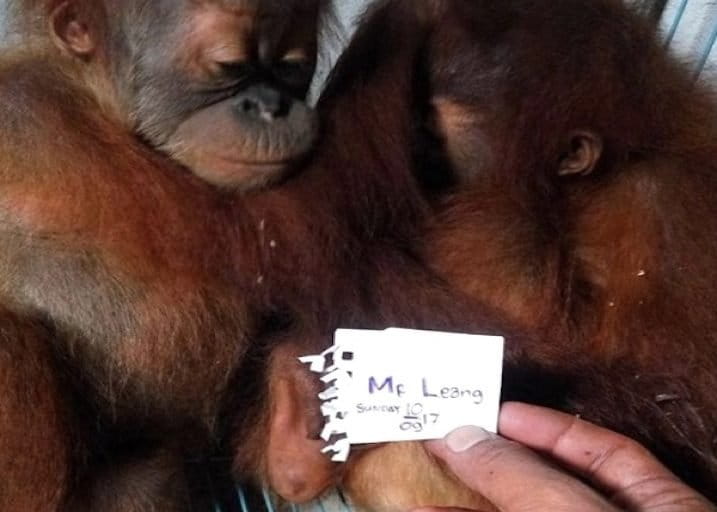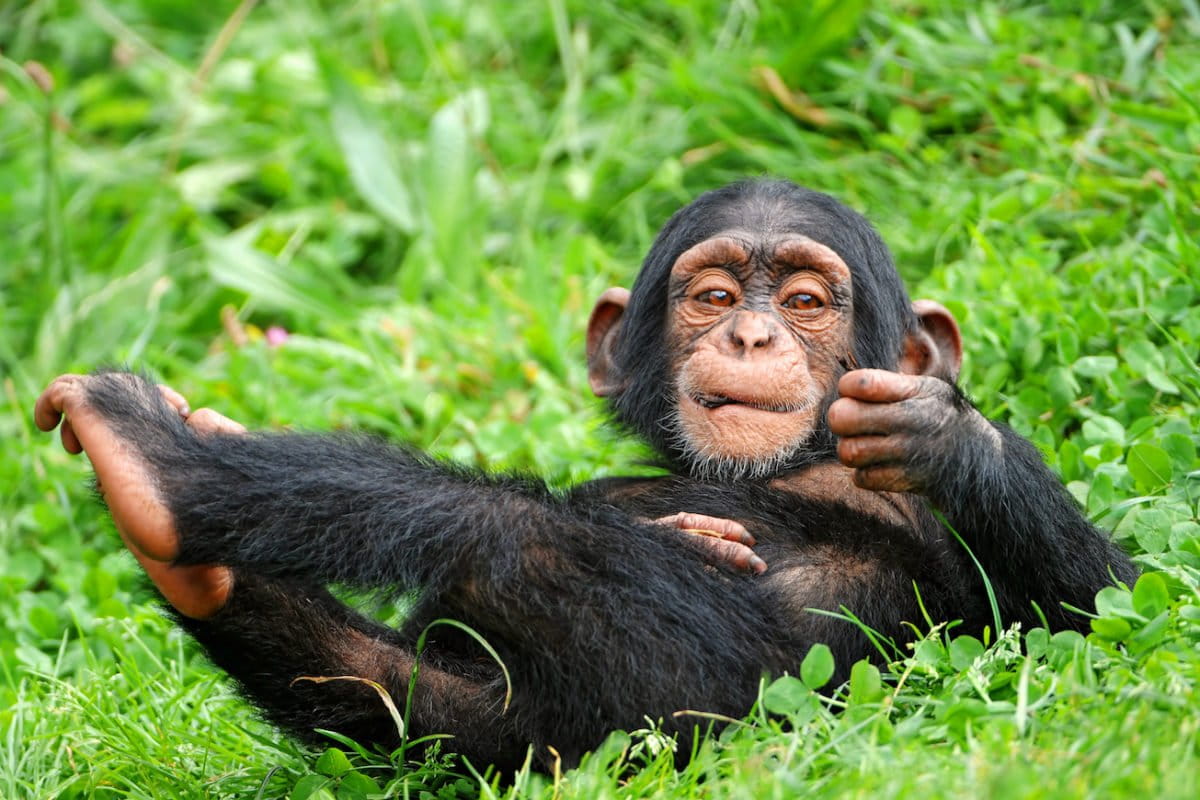- Critically endangered great apes in Africa and Asia are hunted to be sold as pets, for bushmeat, or for their body parts.
- A recent study of the financial aspect of the trade in great apes reveals a complex system of multi-layered supply chains, embedded corruption, and soaring profits for those at the very top of these illicit networks.
- Money connected to ape trafficking runs through the global financial system, often across multiple jurisdictions, opening a potential avenue for legal sanctions against traders.
The illicit great ape trade involves a fusion of brutality and financial sophistication.
Unlike most forms of wildlife trafficking, where animals are killed on the spot, the trafficking of great apes involves the capture of live infants — an unusually cruel process. Chimpanzee mothers, for example, don’t easily give up on their babies and are usually shot and subsequently used for bushmeat. Meanwhile, their traumatized infants are sold on as exotic pets or for use as entertainment in zoos, safari parks and other commercial enterprises.
Despite its cruelty, wildlife trafficking is a multi-billion-dollar industry. According to data from the U.N., the black market for animals is exceeded in value only by the illicit trades in drugs, humans and weapons. But despite the vast sums of money that are connected to wildlife trafficking, a recent report, “Illicit Financial Flows and the Illegal Trade in Great Apes,” finds that there are still many unanswered questions about the financial dynamics of the business.
“For the illegal trade in great apes, attention has often been directed to the ends of the supply chain — the poaching incident and the final consumer purchase,” says Channing May, the lead author of the report and a transnational crime analyst at Global Financial Integrity (GFI), the think tank that published the study. “What remains relatively murky is what goes on in between, that is the ‘business’ of the trade, and more importantly, the financial side of the business.”

Complex supply chains and huge profit margins
To fill in these intelligence gaps, the authors conducted interviews, sent questionnaires, and compiled data from public records. What emerged is a complex picture of multi-layered supply chains, embedded corruption, and soaring profits for those at the very top of these illicit networks.
The authors found that the live trade of infant apes as pets or for entertainment is the most lucrative aspect of the business. However, it’s difficult to calculate an exact value for this trade due to both a lack of hard data and because prices vary widely depending on the specifics of the deal. “It’s a very secretive business and the traffickers don’t issue annual reports,” says Daniel Stiles, an anti-trafficking expert in Kenya and a contributor to the report.
The authors say they believe the average annual value of the market for African live apes is somewhere between $2.1 million and $8.8 million. The value of the orangutan trade could be even greater. Customers buy an average of 143 live orangutans a year, and the combined international and domestic market value for orangutan infants could be anywhere from $277,000 to $10 million per year.
While there’s more money in the live ape trade, it’s the bushmeat trade that takes the greatest toll on ape populations. A study by the Bushmeat Project estimates that approximately 8,000 chimpanzees, gorillas and bonobos are killed each year for food.
The authors did not have enough data to estimate extent or value of the trade in ape body parts, but they cite reporting from Mongabay and organizations such as the Last Great Ape Organization (LAGA) that indicate the existence of a small but profitable market, particularly in Africa.

Who profits
Researchers found that the vast majority of profit went to the dealers. With orangutans, for example, poachers earn $8 to $121 per animal, while dealers can take in up to $20,000 for an individual international sale. This pattern holds with African great apes as well. Dealers of chimpanzees can earn up to a thousand times more than the person who actually acquired the animal.
The disparity in earnings between poachers and dealers is connected to the highly specialist nature of live great ape trafficking.
Transporting large, distinctive-looking animals alive and without getting caught requires both logistical expertise and a vast web of connections. “Bribes are involved all along the route,” the authors write, noting that such payments go to police, soldiers, customs officers and wildlife trade management authorities, as well as local staff of the airlines on which the animals are transported.
Dealers are, therefore, usually well-connected individuals or members of families with close ties to high-ranking members of the military and government.
Although some dealers keep apes in stock, the study found that animals are generally “poached-to-order.” Most of these sales begin on social media platforms such as Facebook and Instagram, with a dealer connecting with potential customers. Once a sale is agreed on, the customer sends half of the amount up front, either through a wire transfer or through a social media platform that allows money transfers, such as the Chinese app WeChat. The dealer then begins the process of ordering the animal from the poacher and organizing its transport.
The researchers found that the most common mode of transport for international orders is on commercial airlines, with Kenya Airways and Ethiopian Airlines the most frequently used. Dealers also smuggle apes by physically concealing them in cargo or declaring them as different species.

CITES and C-scams
Because all great apes are classified as endangered or critically endangered, the commercial trade in wild-caught individuals is completely banned under the Convention on International Trade in Endangered Species of Wild Flora and Fauna (CITES), a multilateral treaty that regulates the export and import of endangered animals and plants.
However, enforcement of CITES takes place at the domestic level, and traffickers have long taken advantage of loopholes, poor governance and inadequate policing, the authors write. One loophole outlined in the report is known as the “C-scam.” Because animals that are captive-bred are subject to less stringent regulations than those born in the wild and can be exported for research or commercial purposes, dealers often bribe CITES officials to place a C on the animal’s form, denoting “captive.”
According to the report, traffickers have been known to purchase fraudulent CITES permits for about $5,000 to export animals out of West and Central Africa, despite no captive breeding facilities existing in the region.

Conspicuous consumption
After being successfully smuggled, the apes go to either a wholesaler or directly to the consumer, explain the authors. The primary buyers of Africa’s great apes are based in Africa, Eastern Europe, the Middle East and China. Consumers are usually looking for exotic pets to display wealth and status, or for entertainment and tourism enterprises. Some entertainment facilities in China, such as safari parks, use great apes in shows or as props to pose in pictures with tourists.
The live orangutan market supplies buyers both domestically in Malaysia and Indonesia, and internationally. The people who own orangutans in Indonesia are mostly politicians or high-ranking members of the military, according to the report, and are largely interested in purchasing orangutans to have in their gardens as a show of conspicuous consumption.
Bushmeat consumers vary, but the market is mostly local, the authors write. In some regions, bushmeat is eaten because other sources of protein are hard to come by. Consumption of bushmeat can also, like the purchase of live apes, be used to display wealth and status. The researchers observed that there is a prevalent belief in parts of Central and West Africa that by eating great apes, people can take in the “essence” of the animal. “Gorillas are seen as ‘big man’s meat’ and equated with power and strength,” they write.

Recommendations
While the illicit trade of great apes is widespread, prosecutions of perpetrators are few and far between, according to the GFI researchers.
Vincent Nijman, an anthropologist specializing in wildlife trafficking at Oxford Brookes University, raised this concern in a paper he published in 2017. The study found that out of the 440 arrests for orangutan trafficking in Indonesia from 1993 to 2016, only seven of the people arrested were prosecuted.
“It’s way too low to act as a deterrent. If it doesn’t act as a deterrent, that gives out the wrong signal to society at large. You are arrested but you can walk free,” he says.
Daniel Stiles concurs. “These guys get arrested, the hard part is getting them prosecuted and keeping them if convicted. Most bribe their way out pretty quickly,” he says.
“The bottom line is that society in West Africa and central Africa and Indonesia is just not supportive enough of protected species laws,” Nijman says.
The report calls on governments to be more diligent in enforcing existing laws related to the trade of great apes.
The authors also urge researchers and investigators to keep shining a light on the lesser-known aspects of the ape trade, such as the financial flows. In particular, they call for closer attention to be paid to payment transfers between dealers and consumers, especially those payments conducted in U.S. dollars.
“There is a strong chance that wire transfers taking place in dollars would go through the U.S. financial system before reaching its final destination; by doing so, this transaction could fall under U.S. legal jurisdiction,” May says.
A focus on financial flows could also help in putting perpetrators behind bars. Breaking protected species laws is rarely the only crime involved in smuggling great apes; there is also tax fraud, money laundering, and health and safety violations. Concentrating on such predicate crimes could be an effective way to ensure accountability in legal systems that often do not give enough weight to species’ protection violations alone, the authors say.
“Remember, Al Capone was not put away for breaking alcohol, prostitution or gambling laws, but for not paying taxes,” says Stiles.
Citations:
- Clough, C., & May, C. (2018). Illicit Financial Flows and the Illegal Trade in Great Apes. Washington, DC: Global Financial Integrity.
- Estrada, A. et al. (2017). Impending extinction crisis of the world’s primates: Why primates matters. Science Advances, 3: 1-16.
- Nijman, V. (2016). Orangutan trade, confiscations, and lack of prosecution in Indonesia. American Journal of Primatology (Commentary): 1-4.
Banner image: A baby chimpanzee, photographed here at a zoo in Switzerland. Image by Tambako The Jaguar via Flickr (CC BY-ND 2.0).
FEEDBACK: Use this form to send a message to the author of this post. If you want to post a public comment, you can do that at the bottom of the page.
